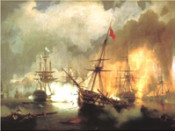
The Battle of Navarino was fought
On October 8 (20) 1827 in Bay of Navarino in the Ionian Sea was fought the naval battle between the allied naval forces of Russia, Britain and France and the combined Ottoman and Egyptian navy.
When Turkey refused to fulfill requirements of the Treaty of London (1827) concerning granting autonomy to the Greece, the united squadron of Russia, Britain and France under the command of the British Vice-Admiral Edward Codrington reached Bay of Navarino, where the Ottoman-Egyptian naval forces commanded by Moharram Bey were concentrated.
The British squadron (Royal Navy squadron) consisted of 3 battleships, 3 frigates, a sloop, 4 brigs and a cutter (total 472 guns). The British squadron was headed by the Vice-Admiral Edward Codrington. The French squadron (Marine Royale de France) commanded by the Rear Admiral Henri de Rigny included 3 battleships, 2 frigates, a brig and a schooner (362 guns). Under the command of the Russian Rear Admiral Lodewijk Heyden (Login Geiden) (Imperial Russian Navy) there were 4 battleships and 4 frigates (466 guns). The united naval forces amounted to 10 battleships, 9 frigates and 7 small ships and about 1 300 guns.
The Turko-Egyptian Navy numbered 3 battleships, 5 two-deck 64-gun frigates, 18 frigates, 42 corvettes, 15 brigs and 6 fire ships (according to various sources there were from 2 100 to 2 600 guns). Entrance into the bay was from two sides fired by 165 guns of coastal batteries, located in the Navarino fortress and on the Sphacteria Island. The Commander-in-Chief of the Ottoman-Egyptian army and navy was Ibrahim Pasha.
On October 8 (20) 1827 allied squadrons started entering the bay in order to occupy the positions in accordance with an agreed disposition. As soon as ships of the British squadron began dropping anchors, Turks opened gun fire and killed the British officer-truce envoy, who was going to enter into negotiations with the Ottoman Admiral. This very moment the Egyptian corvette attacked the French flagship Sirène, and fortress batteries opened a cross fire on the Russian battleship “Azov”, which was in the head of the detachment forcing its way through the narrow strait of Bay of Navarino.
Four hours lasted a fierce battle at a short distance, during which the allied squadrons were operating in a complete unanimity, rendering each other mutual support. The Ottoman-Egyptian Navy was totally destroyed. Most decisively and skillfully performed the Russian squadron under the command of the Rear Admiral Heyden, which inflicted a defeat on the whole center and the right flank of the enemy’s fleet. It took the brunt of the enemy’s attack and destroyed the most of its ships. Losses of the Turkish-Egyptian naval forces totaled over 60 ships and vessels including 3 battleships, 9 frigates, 24 corvettes, 14 brigs. Losses in killed and drowned were over 7 000 men. At night the Turks themselves burnt almost all their remaining ships. As to allies, they did not lose a single ship. Their loss in killed and drowned totaled about 800 men.
The Russian battleship “Azov” under the command of the Captain 1st class M.P. Lazarev distinguished itself in the battle. “Azov” drowned 2 frigates and a corvette, burnt a 60-gun frigate under the flag of Tahir Pasha, forced an 80-gun ship run aground, and then jointly with British allies destroyed the Ottoman flagship.
In his report on the Battle of Navarino the Rear Admiral Count Heyden wrote: “Three allied navies competed one another in bravery. Never has there been such a sincere unanimity between different nations. During the Battle of Navarino the British Navy appeared in its new luster of fame, as to the French squadron, all officers starting from Admiral Rigny displayed rare examples of courage and fearlessness. Captains and other officers of the Russian squadron performed their duty with exemplary zeal, bravery and contempt for all dangers, lower ranks distinguished themselves with courage and obedience, being worth of emulation”.
For military exploits the battleship “Azov” was for the first time in the history of the Russian navy awarded with a Saint George ensign and a pennant. Its commander Captain 1st class M.P. Lazarev was promoted to Rear Admiral. Rear Admirals L.P. Heyden became a Vice Admiral, holder of the Third Class Order of Saint George, the French Order of Saint Louis and the British Order of the Bath. The majority of officers of the Russian squadron received Russian, British and French orders and promotion.
Lit.: Богданович Е. В. Наварин. 1827-1877. М., 1877; Броневский В. Наваринская битва 8 октября 1827 г. // Военный журнал. 1829. № 3. С. 31; Боевая летопись русского флота: Хроника важнейших событий военной истории русского флота с IX в. по 1917 г. М., 1948. Разд. 4. Гл. 8. Наваринская кампания 1827 года;То же [Электронный ресурс]. URL: http://militera.lib.ru/h/boevaya_letopis_flota/26.html; Рыкачев А. П. Год Наваринской кампании. 1827 и 1828 гг. Кронштадт, 1877; Рыкачев А. П. Записки, ведённые на эскадре Л. П. Гейдена. Наваринское сражение // Морские сражения русского флота. Воспоминания, дневники, письма. М., 1994; Сирый С. П. Наваринское сражение [Электронный ресурс] // Морская газета. 1998-2016. URL: http://gazetam.ru/23-oktyabrya/navarinskoe-srazhenie.htm; 8 октября 1827 г. Наваринское сражение [Электронный ресурс] // ВМФ России. Б. д. URL: http://www.navy.su/daybyday/october/08/index.htm.
Based on the Presidential Library’s materials:
Белавенец П. И. Двухсотлетие русского флота. (1696-1896). Кронштадт, 1896. С. 20;
Российское наследие за рубежом: проблемы сохранения исторической памяти // Новости. 5 декабря;
Хронологический указатель военных действий русской армии и флота. Т. 3. СПб., 1911. С. 63.

